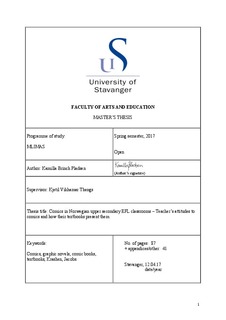| dc.description.abstract | The aim of the present master’s thesis was to find out how a selected group of teachers view comics in general, and to look at the use of comics in their textbooks. Three textbooks, Targets, Gateways YF and Access, were studied, and six participants agreed to participate in an interview about their textbooks.
A semistructured interview was chosen in order to get reflective answers from the participating teachers. The textbooks were chosen because they were the ones used in the English classroom by the participating teachers.
The findings show that comics are not given much space in the participating teachers’ classrooms, nor in the textbooks they use. Targets’ comic is used as a simplification of another text. The participating teachers had not used it, which suggests that it was not seen as significant. Gateways YF’s comic was regarded as a comic and not just any other text. However, the participating teachers had not used it, which suggests that it was not seen as worthwhile. Access favoured other kinds of texts, and it did not have any examples of comics in it; one of the participating teachers thought this was a shame, while the other teacher who used this textbook had not missed them.
The participating teachers’ knowledge of comics and their use was limited. When comics were used, they were rather included because they were easy or entertaining than that they had value on their own. The participating teachers saw comics as useful, but when comics were used, they were not applied to the fullest extent. Some of their positive thoughts about comics were that they were fun, creative, different and engaging. Some of the negative sides the participating teachers brought up with regard to using comics in the classroom, were that comics had less text, that they represented an oversimplification and that they disturb image creation. Regarding how comics should be used English education in the upper secondary Norwegian classroom, some of the points that were brought up were that comics could be used as a supplement and that that they could be used as a summing up exercise.
The participating teachers’ opinions of comics are comparable to Krashen’s view that comics are a conduit to reading more ‘regular’ texts. According to this view, comics do not possess other values then being easier and more engaging for pupils to read, as opposed to what Jacobs points out, namely that comics should be seen as a great way to teach multimodality in the classroom. Because of limited knowledge of how to use comics in the classroom, the participating teachers used them only to a minor extent, in their teaching. | nb_NO |
